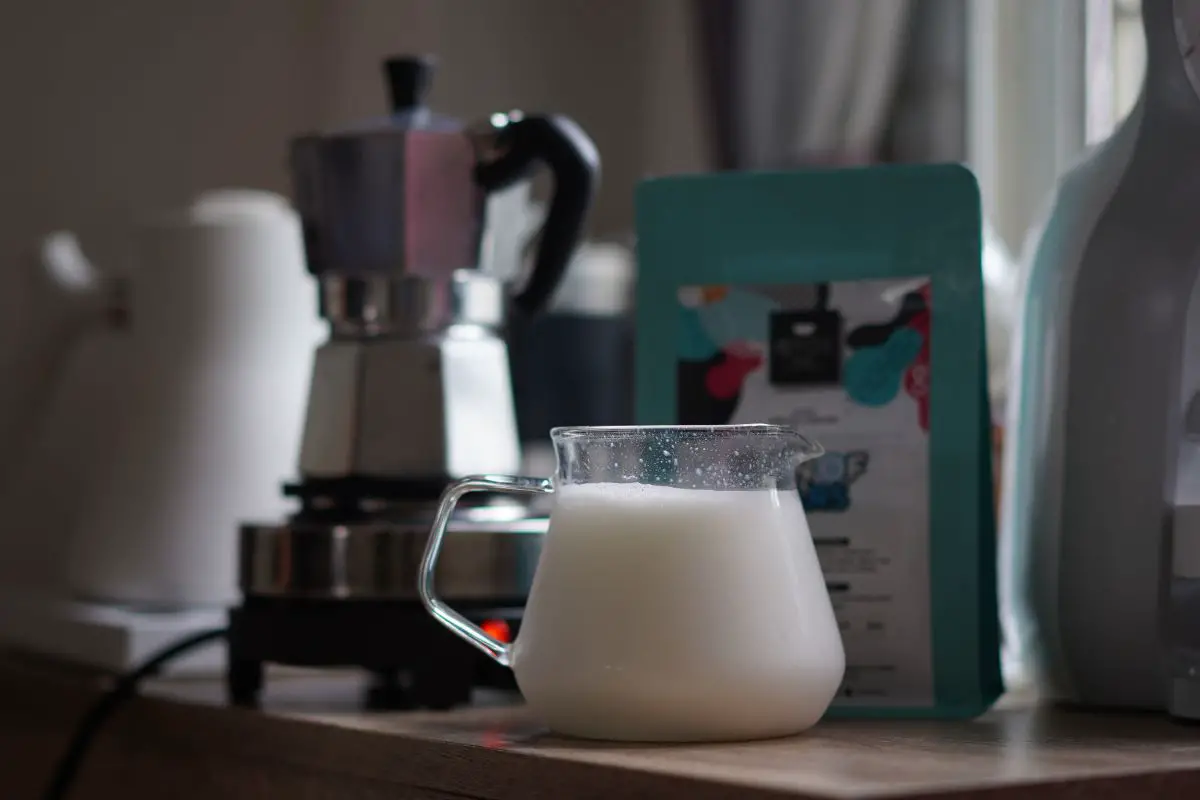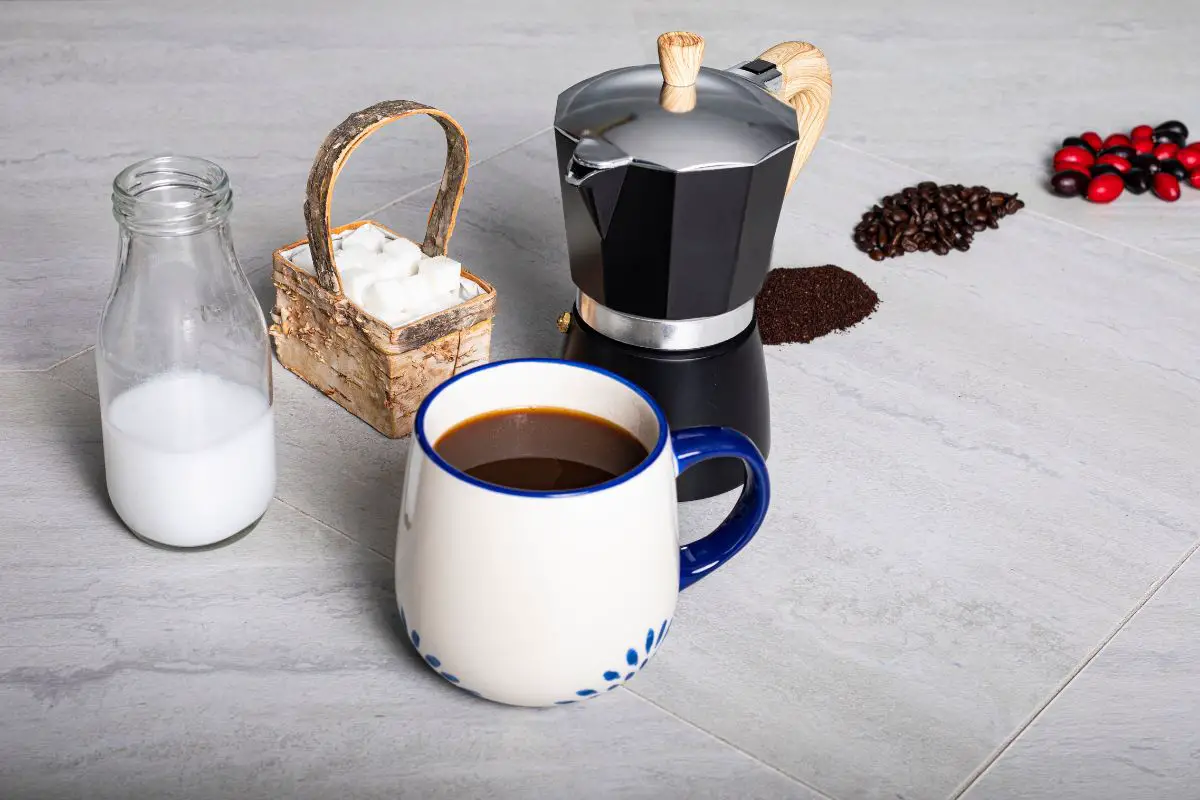In the realm of coffee brewing, the Moka pot has long been hailed as an essential tool for creating a rich and satisfying cup of joe. Its unique design and brewing process have captivated coffee enthusiasts for decades, producing a bold and robust flavor that rivals that of a traditional espresso machine.

However, the question remains: can you use milk in a Moka pot? This inquiry has sparked a debate among coffee connoisseurs, with some arguing that the addition of milk can enhance the taste and texture of the final brew, while others caution against it due to potential safety concerns.
In this article, we will delve into the function of a Moka pot, explore the pros and cons of using milk in this brewing method, and provide expert insights on experimenting with different milk varieties. So, if you’re a fan of creamy coffee creations and want to explore the possibilities of incorporating milk into your Moka pot brewing routine, read on to discover the dos and don’ts of this intriguing coffee concoction.
Key Takeaways
- Using milk in a Moka pot is not recommended due to safety concerns and design
- Milk can clog the filter basket, affect steam flow, and may scorch at high temperatures
- Experimenting with different milk varieties can impact taste and texture of the coffee
- If desired, heat milk separately and add it to the brewed coffee to avoid excessive heat exposure to coffee grounds.
Understanding the Function of a Moka Pot
The Moka pot is a traditional Italian coffee-making device that functions by using steam pressure to brew a strong cup of coffee. It consists of a lower chamber where water is heated, creating steam, and an upper chamber where the brewed coffee collects.
As the water in the lower chamber boils, steam is created, which then passes through the coffee grounds in the filter basket and rises to the upper chamber. This process results in a rich and robust cup of coffee.
Using milk in a Moka pot is not recommended due to several reasons. Firstly, the Moka pot is designed specifically for brewing coffee, and its mechanism may not be suitable for heating and frothing milk. Secondly, milk has a higher fat content compared to water, which can lead to clogging the filter basket and affecting the smooth flow of steam. Moreover, the high temperature required for brewing coffee in a Moka pot may cause the milk to scorch and develop an unpleasant taste.
While the Moka pot is an excellent device for brewing coffee, it is not designed for the use of milk.
Next, we will explore the pros and cons of using milk in a Moka pot.
Pros and Cons of Using Milk in a Moka Pot
One interesting statistic to consider is that incorporating milk in the brewing process of a moka pot can alter the taste profile of the resulting coffee, potentially enhancing its richness and creaminess. However, there are both pros and cons to using milk in a moka pot.
On the positive side, adding milk to the moka pot can create a velvety texture and add a smoothness to the coffee. This can be particularly appealing for those who enjoy a creamier cup of coffee. Milk can also help to balance out any bitterness or acidity in the coffee, resulting in a more well-rounded flavor profile. Additionally, using milk in a moka pot allows for the creation of various coffee-based beverages such as lattes and cappuccinos, expanding the range of options for coffee enthusiasts.
On the other hand, there are some potential drawbacks to using milk in a moka pot. First, the presence of milk can increase the risk of scorching or burning the coffee, as milk has a lower boiling point than water. This can lead to a burnt taste and unpleasant aroma. Additionally, using milk in the moka pot requires more careful cleaning and maintenance to prevent the buildup of milk residues, which can affect the flavor of future brews.
Incorporating milk in a moka pot can enhance the richness and creaminess of the resulting coffee, but it also comes with some potential downsides. It is important for coffee enthusiasts to be aware of these pros and cons when deciding whether to use milk in their moka pot brewing process.
Transitioning to the subsequent section about experimenting with different milk varieties, it is worth exploring the impact of using different types of milk on the taste and texture of the coffee.
Experimenting with Different Milk Varieties
An interesting aspect to explore is the impact of using various types of milk on the taste and texture of coffee brewed in a moka pot. Experimenting with different milk varieties can provide a unique and enjoyable experience for coffee enthusiasts.
Here are three possibilities to consider:
- Whole milk: Using whole milk in a moka pot can result in a creamy and rich cup of coffee. The high fat content of whole milk adds a velvety texture and enhances the overall flavor profile.
- Low-fat milk: For those seeking a lighter option, low-fat milk can be used. It still provides a smooth texture but with a slightly less creamy taste compared to whole milk.
- Plant-based milk alternatives: People who prefer dairy-free options can explore plant-based milk alternatives like almond, soy, or oat milk. These varieties can impart their unique flavors into the coffee, adding a nutty or slightly sweet taste.
When experimenting with different milk varieties, it is important to consider individual preferences and any dietary restrictions. Adjusting the brewing process to accommodate different milk types can further enhance the taste and texture of coffee brewed in a moka pot.
Adjusting the Brewing Process
Adjusting the brewing process in order to achieve the perfect cup of coffee from a moka pot involves carefully controlling the temperature and grind size to maximize extraction and highlight the unique flavors of the beans.
Temperature plays a crucial role in the brewing process, as it affects the extraction rate and the overall taste of the coffee. It is important to preheat the water before adding it to the moka pot, as this ensures that the coffee grounds are brewed at the optimal temperature.
Additionally, adjusting the grind size can also greatly impact the quality of the coffee. Finer grinds result in a stronger flavor, while coarser grinds produce a milder taste. By experimenting with different grind sizes, coffee enthusiasts can find the perfect balance that suits their preferences.
Furthermore, it is important to monitor the brewing time to prevent over-extraction, which can result in a bitter taste.
By carefully following these steps, coffee lovers can achieve a rich and flavorful cup of coffee from their moka pot.
Moving on to taste and texture considerations, it is important to consider the different milk varieties that can be used in the moka pot.
Taste and Texture Considerations
Considering the diverse range of milk options available, the moka pot allows for the creation of a velvety, creamy texture that enhances the overall coffee experience. The use of milk in a moka pot can add richness and depth to the coffee, resulting in a smoother and more balanced taste. The moka pot’s unique brewing process extracts the flavors and oils from the coffee grounds, and when combined with milk, it creates a harmonious blend that appeals to those who prefer a creamier coffee.
When using milk in a moka pot, it is essential to consider the type of milk used. Whole milk tends to provide the creamiest texture, while low-fat or skim milk may result in a thinner consistency. Additionally, the milk should be heated separately before adding it to the moka pot. This ensures that the coffee grounds are not exposed to excessive heat, which could lead to a burnt or bitter taste.
In terms of taste, adding milk to a moka pot brew can mellow out any bitterness or acidity in the coffee, resulting in a smoother and more balanced flavor profile. The milk also adds a touch of sweetness, enhancing the overall taste experience.
Using milk in a moka pot can create a velvety and creamy texture while enhancing the taste of the coffee. However, there are alternative methods for adding milk to your coffee that can also provide similar results.
Alternative Methods for Adding Milk to Your Coffee

One potential option for incorporating milk into your coffee is by utilizing alternative methods that can yield similar results in terms of taste and texture.
These methods can be particularly useful for those who prefer using a moka pot to brew their coffee.
One option is to heat the milk separately and then add it to the brewed coffee. This method allows for more control over the temperature of the milk, as it can be heated to the desired level without affecting the brewing process of the moka pot.
Another option is to use a frother to create foam from the milk, which can then be added to the brewed coffee. This can provide a creamy texture and enhance the overall experience of the coffee.
It is important to note that when using alternative methods to add milk to your coffee, it is crucial to ensure that the milk is heated and frothed properly to prevent any potential health risks. It is recommended to follow safety guidelines and best practices when handling and preparing milk to maintain a safe and enjoyable coffee experience.
Frequently Asked Questions
Can I use non-dairy milk alternatives in a Moka pot?
Non-dairy milk alternatives can be used in a moka pot, but caution must be exercised. Due to their different compositions, these alternatives may affect the taste and consistency of the coffee. Testing and adjusting the brewing process may be necessary to achieve desired results.
Will using milk in a Moka pot affect the brewing time?
Using milk in a moka pot does not significantly affect brewing time. However, it may alter the taste and texture of the final beverage. It is important to note that proper cleaning of the moka pot is necessary to prevent any residue buildup.
Can I froth the milk in a Moka pot?
Frothing milk in a moka pot is not recommended. Moka pots are designed for brewing coffee, not for frothing milk. Attempting to froth milk in a moka pot can lead to safety hazards and may damage the equipment.
What is the best type of milk to use in a Moka pot?
The best type of milk to use in a moka pot depends on personal preference. However, it is generally recommended to use whole milk for a richer and creamier taste.
Can I use flavored milk in a Moka pot?
Flavored milk should not be used in a moka pot due to the added ingredients, such as sugar and flavorings, which can cause the pot to clog and affect the brewing process. Stick to regular milk for optimal results.
Conclusion
In conclusion, the utilization of milk in a Moka pot can be a delicate balance of flavors and textures. By understanding the function of the Moka pot and the pros and cons of incorporating milk, coffee enthusiasts can experiment with different milk varieties and adjust the brewing process accordingly. This allows for a customized taste and texture experience, enhancing the overall enjoyment of the coffee.
However, it is important to consider alternative methods for adding milk to your coffee, as each individual’s preferences may vary. The possibilities are endless, and with a little experimentation, a delightful and satisfying cup of coffee awaits.
Related articles: